Compositions and Microstructures of Carbonated Geopolymers with Different Precursors
Abstract
:1. Introduction
2. Materials and Methods
2.1. Sample Preparation and Carbonation
2.2. XRD Analysis
2.3. SEM-EDS Analysis
3. Results and Discussion
3.1. Carbonation
3.1.1. Method of XRD Identification
3.1.2. Results of XRD Identification
3.2. Matrix Gels
3.2.1. SEM-EDS Images and Element Maps
3.2.2. Matrix Gel Compositions Detected by Point Analysis of SEM-EDS
3.2.3. Ternary Diagram Analyses
SiO2-(CaO + MgO + Na2O)-Al2O3 Diagram
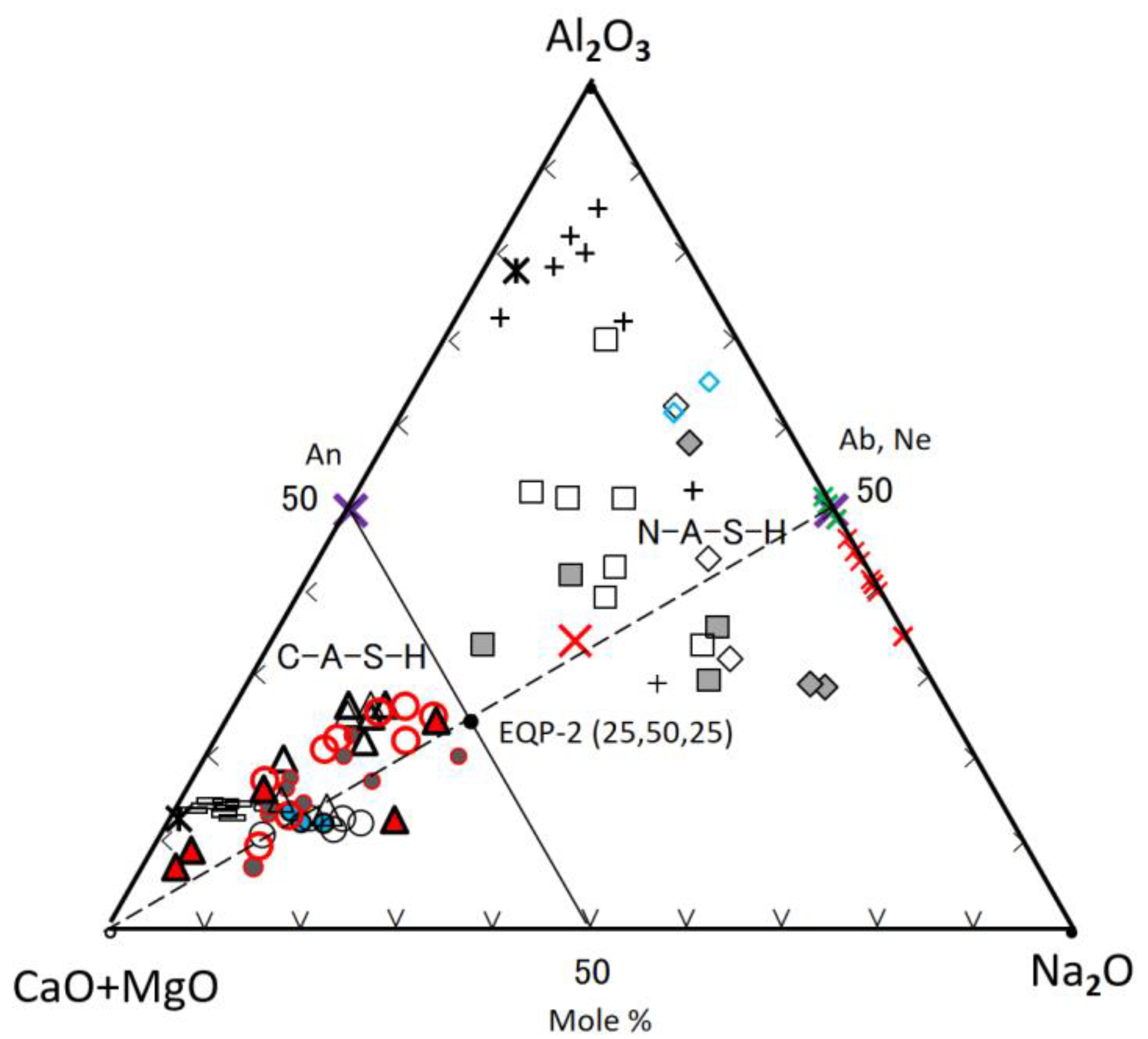
Al2O3-(CaO + MgO)-Na2O Diagram
4. Conclusions
Author Contributions
Funding
Institutional Review Board Statement
Informed Consent Statement
Data Availability Statement
Acknowledgments
Conflicts of Interest
References
- Davidovits, J. Geopolymers: Inorganic polymeric new materials. J. Term. Anal. 1991, 37, 1633–1656. [Google Scholar] [CrossRef]
- Li, Z. Environmental impact assessment of fly/slag blend-based geopolymer concrete. In Proceedings of the Symposium on Current Status and Issues of Geopolymer Technology in Construction Industry, Tokyo, Japan, 24 June 2016; pp. 43–50. [Google Scholar]
- Mikuni, A.; Wei, C.; Komatsu, R.; Ikeda, K. Thermal alteration of kaolins and elution properties of calcined products in alkali solution. J. Soc. Inorg. Mat. Jpn. 2005, 12, 115–121. [Google Scholar]
- Raphaëlle, P.; Martin, C. Formulation and performance of flash metakaolin geopolymer concretes. Const. Build. Mat. 2016, 120, 150–160. [Google Scholar]
- Palomo, A.; Alonso, S.; Fernández-Jiménez, A. Alkaline activation of fly ashes: NMR study of the reaction products. J. Am. Ceram. Soc. 2004, 87, 1141–1145. [Google Scholar] [CrossRef]
- Rangan, B.V. Fly Ash-Based Geopolymer Concrete; Research Report GC4; Curtin University of Technology: Perth, Australia, 2008; pp. 1–44. [Google Scholar]
- Rattanasak, U.; Chindaprasirt, P. Influence of NaOH solution on the synthesis of fly ash geopolymer. Miner. Eng. 2009, 22, 1073–1078. [Google Scholar] [CrossRef]
- Ikeda, K. Preparation of fly ash monoliths consolidated with a sodium silicate binder at ambient temperature. Cem. Concr. Res. 1997, 27, 657–663. [Google Scholar] [CrossRef]
- Harada, K.; Ichimiya, K.; Tugo, S.; Ikeda, K. A consideration on some properties of geopolymer. Proc. Jpn. Conc. Inst. JCI 2012, 34, 1894–1899. Available online: www.data.jci-net.or.jp/data_pdf/34/034-01-1308.pdf (accessed on 27 January 2024). (In Japanese).
- Wagners, P.R. EFC Geopolymer Pavements at Wellcamp Airport, Australia—YouTube. Available online: https://www.youtube.com/watch?v=ChbklgUMWdo (accessed on 27 January 2024).
- AfriSam, P.R. 0% Cement Concrete—M&R Geopolymer Concrete a South African First!!—YouTube. Available online: https://www.youtube.com/watch?v=wArEbfC91m0 (accessed on 27 January 2024).
- Rayment, D.L.; Majumdar, A.J. The composition of the C-S-H phases in Portland cement pastes. Cem. Concr. Res. 1982, 12, 753–764. [Google Scholar] [CrossRef]
- Taylor, H.F.W. Proposed structure for calcium silicate hydrate gel. J. Am. Ceram. Soc. 1986, 69, 464–467. [Google Scholar] [CrossRef]
- Faucon, P.; Charpentier, T.; Nonat, A.; Petit, J.C. Triple-quantum two-dimensional 27Al magic angle nuclear magnetic resonance study of the aluminum incorporation in calcium silicate hydrates. J. Am. Chem. Soc. 1998, 120, 12075–12082. [Google Scholar] [CrossRef]
- Faucon, P.; Delagrave, A.; Petit, J.C.; Richet, C.; Marchand, J.M.; Zanni, H. Aluminum incorporation in calcium silicate hydrates (C-S-H) depending on their Ca/Si ratio. J. Phys. Chem. B 1999, 103, 7796–7802. [Google Scholar] [CrossRef]
- Stade, H.; Müller, D. On the coordination of Al in ill-crystallized C-S-H phases formed by hydration reactions at ambient temperature. Cem. Concr. Res. 1987, 17, 553–561. [Google Scholar] [CrossRef]
- Brough, A.R.; Atkinson, A. Sodium silicate based alkali-activated slag mortars Part I. Strength, hydration and microstructure. Cem. Concr. Res. 2002, 32, 865–879. [Google Scholar] [CrossRef]
- Richardson, I.G.; Braugh, A.R.; Groves, G.W.; Dobson, V.M. The characterization of hardened alkali-activated blast-furnace slag pastes and the nature of the calcium silicate hydrate (C-S-H) phase. Cem. Concr. Res. 1994, 24, 813–829. [Google Scholar] [CrossRef]
- Schlling, P.J.; Butler, L.G.; Roy, A.; Eaton, H.C. 29Si and 27Al MAS-NMR of NaOH-activated blast-furnace slag. J. Am. Ceram. Soc. 1994, 77, 2363–2368. [Google Scholar] [CrossRef]
- L’Hôpital, E.; Lothenbach, B.; Le Saout, G.; Kulik, D.; Scrivener, K. Incorporation of aluminium in calcium-silicate hydrates. Cem. Concr. Res. 2015, 75, 91–103. [Google Scholar] [CrossRef]
- L’Hôpital, E.; Lothenbach, B.; Scrivener, K.; Kulik, D.A. Alkali uptake in calcium alumina silicate hydrate (C-A-S-H). Cem. Conc. Res. 2016, 85, 122–136. [Google Scholar] [CrossRef]
- Puertas, F.; Palacios, M.; Manzano, H.; Dolado, J.S.; Rico, A.; Rodríguez, j. A model for the C-A-S-H gel formed in alkali-activated slag cements. J. Euro Ceram. Soc. 2011, 31, 2043–2056. [Google Scholar] [CrossRef]
- Myers, R.J.; Bernal, S.A.; Nicolas, R.S.; Provis, J.L. Generalized structural description of calscium-sodium aluminosilicate hydrate gels: The cross-linked substituted tobermorite model. Langmuir 2013, 29, 5294–5306. [Google Scholar] [CrossRef]
- Myers, R.J.; Bernal, S.A.; Provis, J.L. A thermodynamic model for C-(N)-A-S-H gel: CNASH_ss. deviation and validation. Cem. Conc. Res. 2014, 66, 27–47. [Google Scholar] [CrossRef]
- Loewenstein, W. The distribution of aluminum in the tetrahedra of silicates and aluminates. Am. Miner. 1954, 39, 92–96. [Google Scholar]
- Tossell, J.A. A theoretical study of the molecular basis of the Al avoidance rule and of the spectral characteristics of Al-O-Al linkages. Am. Miner. 1993, 78, 911–920. [Google Scholar]
- Provis, J.L.; Bernal, S.A. Geopolymers and related alkali-activated materials. Annu. Rev. Mater. Res. 2014, 44, 299–327. [Google Scholar] [CrossRef]
- Palomo, A.; Krivenko, P.; Garcia-Lodeiro, I.; Kavalerova, E.; Maltseva, O.; Fernández-Jiménez, A. A review on alkaline activation: New analytical perspectives. Mater. Construcción 2014, 64, e022. [Google Scholar] [CrossRef]
- Fernández-Jiménz, A.; Puertas, F.; Sobrados, I.; Sanz, J. Structure of calcium silicate hydrate formed in alkaline activated slag. Influence of the type of alkaline activator. J. Am. Ceram. Soc. 2003, 86, 1389–1394. [Google Scholar] [CrossRef]
- Kwan, S.; LaRosa-Thompson, J.; Grutzeck, M.W. Structures and phase relations of aluminum-substituted calcium silicate hydrate. J. Am. Ceram. Soc. 1996, 79, 967–971. [Google Scholar] [CrossRef]
- Yamaguchi, N.; Nagaishi, M.; Kisu, K.; Nakamura, Y.; Ikeda, K. Preparation of monolithic geopolymer materials from urban waste incineration slags. J. Ceram. Soc. Jpn. 2013, 121, 847–854. [Google Scholar] [CrossRef]
- García-Lodeiro, I.; Palomo, A.; Fernández-Jiménez, A.; Macphee, D.E. Compatibility studies between N-A-S-H and C-A-S-H gels. Study in the ternary diagram Na2O-CaO-Al2O3-SiO2-H2O. Cem. Concr. Res. 2011, 41, 923–931. [Google Scholar] [CrossRef]
- García-Lodeiro, I.; Fernández-Jiménez, A.; Palomo, A. Variation in hybrid cements over time, Alkaline activation of fly ash-portland cement blends. Cem. Concr. Res. 2013, 52, 112–122. [Google Scholar] [CrossRef]
- Ismail, I.; Bernal, S.A.; Provis, J.L.; Nicolas, R.S.; Hamdan, S.; van Deventer, J.S.J. Modification of phase evolution in alkali-activated blast furnace slag by the incorporation of fly ash. Cem. Concr. Comp. 2014, 45, 125–135. [Google Scholar] [CrossRef]
- Li, Z.; Nagashima, M.; Ikeda, K. Treatment technology of hazardous water contaminated with radioisotopes with paper sludge ash-based geopolymer—Stabilization of immobilization of strontium and cesium by mixing seawater. Materials 2018, 11, 1521. [Google Scholar] [CrossRef]
- García-Lodeiro, I.; Fernández-Jiménez, A.; Palomo, A.; Macphee, D.E. Effect of calcium addition on N-A-S-H cementitious gels. J. Am. Ceram. Soc. 2010, 93, 1934–1940. [Google Scholar] [CrossRef]
- Li, Z.; Li, S. Carbonation resistance of fly ash and blast furnace slag based geopolymer concrete. Constr. Build. Mater. 2018, 163, 668–680. [Google Scholar] [CrossRef]
- Li, Z.; Li, S. Effects of wetting and drying on alkalinity and strength of fly ash/slag-activated materials. Const. Build. Mat. 2020, 254, 119069. [Google Scholar] [CrossRef]
- Suda, Y.; Saeki, T.; Saito, T. Effect of chemical composition of C-S-H on volume and pore size distribution of gel pore. J. Jpn. Soc Civ. Eng Ser. E2 2014, 70, 134–152, (In Japanese with English Abstract). [Google Scholar] [CrossRef]
- Rodriguez, E.T.; Garbev, K.; Merz, D.; Black, L.; Richardson, I.G. Thermal stability of C-S-H phases and applicability of Richardson and Groves’ and Richardson C-(A)-S-H(I) models to synthetic C-S-H. Cem. Concr. Res. 2017, 93, 45–56. [Google Scholar] [CrossRef]
- Igarashi, G.; Maruyama, I. Relationship between specific surface area and hydration reaction of hardened cement paste. Cem. Sci. Conc. Tec. 2010, 64, 103–110, (In Japanese with English Abstract). [Google Scholar] [CrossRef]
- Miyamoto, S. A review of thermodynamic phase equilibrium calculation model of calcium silicate hydrate. Concr. J. JCI 2020, 58, 467–474, (In Japanese with English abstract). [Google Scholar]
- Taylor, H.F.W. The Chemistry of Cements; Academic Press: London, UK, 1964; Volume 1, p. 460. [Google Scholar]
- Arai, Y. Materials Chemistry of Cements, 2nd ed.; Dainihon-Tosho: Tokyo, Japan, 2002; p. 262. ISBN 4-477-14412-1. (In Japanese) [Google Scholar]
- Nonat, A. The structure and stoichiometry of C-S-H. Cem. Concr. Res. 2004, 34, 1521–1528. [Google Scholar] [CrossRef]
- Wang, J.; Zhou, T.; Xu, D.; Zhou, Z.; Du, P.; Xie, N.; Cheng, X.; Liu, Y. Effect of nano-silica on the efflorescence of waste based alkali-activated inorganic binder. Const. Build. Mat. 2018, 167, 381–390. [Google Scholar] [CrossRef]
- Li, J.; Yu, Q.; Huang, H.; Yin, S. Effects of Ca/Si ratio and Al on the carbonation resistance of C-S-H gels. In Proceedings of the 15th International Congress on the Chemistry of Cement, Prague, Czech Republic, 16–20 September 2019; p. 11. [Google Scholar]
- Bernal, S.A.; Provis, J.L.; Walkley, B.; Nicolas, R.S.; Gehman, J.D.; Brice, D.J.; Kilcullen, A.R.; Duxson, P.; van Deventer, J.S. Gel nanostructure in alkali-activated binders based on slag and fly ash and effects of accelerated carbonation. Cem. Conc. Res. 2013, 53, 127–144. [Google Scholar] [CrossRef]
- Li, Z.; Ikeda, K. Application of preheating treatment to setting control of geopolymer cement using ground granulated blast furnace slag. In Proceedings of the 15th International Congress on the Chemistry of Cement, Prague, Czech Republic, 16–20 September 2019; p. 10. [Google Scholar]
- Ikeda, K.; Li, Z. Development of paper sludge ash-based geopolymer and application to the solidification of nuclear waste water. In Proceedings of the 14th International Congress on the Chemistry of Cement, Beijing, China, 13–16 October 2015; p. 15. [Google Scholar]
- Li, Z.; Ohnuki, T.; Ikeda, K. Development of paper sludge ash-based geopolymer and application to treatment of Hazardous water contaminated with radioisotopes. Materials 2016, 9, 633–649. [Google Scholar] [CrossRef] [PubMed]
- Shannon, R.D.; Prewitt, C.T. Effective ionic radii in oxides and fluorides. Acta Cryst. 1969, B25, 925–946. [Google Scholar] [CrossRef]
- Shannon, R.D. Revised effective ionic radii and systematic studies of interatomic distances in halides and chalcogenides. Acta Cryst. 1976, CA32, 751–767. [Google Scholar] [CrossRef]
- Feng, D.; Mikuni, A.; Hirano, Y.; Komatsu, R.; Ikeda, K. Preparation of geopolymeric materials from fly ash filler by steam curing with special reference to binder products. J. Ceram. Soc. Jpn. 2005, 113, 82–86. [Google Scholar] [CrossRef]
- Hashimoto, R.; Morita, M.; Umezawa, O.; Motoda, S. Effect of ions eluted from metal surface on transformation and growth of calcium carbonate polymorphisms. J. Jpn. Inst. Met. Mater. 2017, 81, 89–96. Available online: https://www.jstage.jst.go.jp/article/jinstmet/81/2/81_J2016045/_pdf (accessed on 27 January 2024). (In Japanese with English Abstract). [CrossRef]
- Ming, N.; Buddy, D.R. Differentiation of calcium carbonate polymorphs by surface analysis techniques—An XPS and TOF-SIMS study. Surf. Interface Anal. 2008, 40, 1356–1361. [Google Scholar]
- Kalina, L.; Bílek, V., Jr.; Šafář, M.; Másilko, J.; Koplík, J.; Opravil, T. Use of waste technological sludge for the production of alkali activated concrete. In Proceedings of the 14th International Congress on the Chemistry of Cement, Beijing, China, 13–16 October 2015; p. 7. [Google Scholar]
- Harada, K.; Ichimiya, K.; Tugo, S.; Ikeda, K. Fundamental study on durability of geopolymer mortars. In Proceedings of the Japan Concrete Institute, Osaka, Japan, 12–14 July 2011; Volume 33, pp. 1937–1942. Available online: www.data.jci-net.or.jp/data_pdf/33/033-01-1317.pdf (accessed on 27 January 2024). (In Japanese).
- Kamel, A.; Marija, N.; Yibing, Z.; Guang, Y. A Review on the durability of alkali-activated fly ash/slag systems: Advances, issues, and perspectives. Ind. Eng. Chem. Res. 2016, 55, 5439–5453. [Google Scholar]
- Mikuni, A.; Komatsu, R.; Ikeda, K. Dissolution properties of some fly ash fillers applying to geopolymeric materials in alkali solution. J. Mater. Sci. 2007, 42, 2953–2957. [Google Scholar] [CrossRef]
- Davidovits, J.; Davidovits, R. Ferro-Sialate Geopolymers (-Fe-O-Si-O-Al-O-); Technical Paper #27; Geopolymer Institute Library: Saint Quentin, France, 2020; pp. 1–6. [Google Scholar]
- Kamseu, E.; Kaze, C.R.; Fekoua, J.N.N.; Melo, U.C.; Rossignol, S.; Leonelli, C. Ferrisilicates formation during the geopolymerization of natural Fe-rich aluminosilicate precursors. Mat. Chem. Phys. 2020, 240, 122062. [Google Scholar] [CrossRef]
- Bernard, E.; Lothenbach, B.; Le Goff, F.; Pochard, I.; Dauzères, A. Effect of magnesium on calcium silicate hydrate (C-S-H). Cem. Concr. Res. 2017, 97, 61–72. [Google Scholar] [CrossRef]
- Bernard, E.; Lothenbach, B.; Cau-Dit-Coumes, C.; Chlique, C.; Dauzères, A.; Pochard, I. Magnesium and calcium silicate hydrates, Part I: Investigation of the possible magnesium incorporation in calcium silicate hydrate (C-S-H) and of the calcium in magnesium silicate hydrate (M-S-H). Appl. Geochem. 2018, 89, 229–242. [Google Scholar] [CrossRef]
- Walkley, B.; Nicolas, R.S.; Sani, M.-A.; Bernal, S.A.; van Deventer, J.S.J. Structural evolution of synthetic alkali-activated CaO-MgO-Na2O-Al2O3-SiO2 materials is influenced by Mg content. Cem. Concr. Res. 2017, 99, 155–171. [Google Scholar] [CrossRef]
- Mitsuda, T.; Kobayakawa, S.; Toraya, H. Characterization of hydrothermally formed C-S-H. In Proceedings of the 8th International Congress on the Chemistry of Cement, Rio de Janeiro, Brazil, 22–27 September 1986; Volume 3, pp. 173–178. [Google Scholar]
- Iwahiro, T.; Komatsu, R.; Ikeda, K. Chemical compositions of gels prepared from sodium metasilicate and aluminum nitrate solutions. In Proceedings of the Geopolymers 2002, Melbourne, Australia, 28–29 October 2002; Volume 1, pp. 176–183. [Google Scholar]
- Ishida, T.; Ichiba, D.; Kawai, K. Effects of carbon dioxide gas concentration on carbonation of C-S-H. Cem. Sci. Conc. Technol. 2009, 63, 347–353, (In Japanese with English Abstract). [Google Scholar] [CrossRef]
- Ishida, T.; Ito, Y.; Kawai, K. Carbonation characteristics of the C-S-H with various Ca/Si ratios. Cem. Sci. Conc. Technol. 2013, 67, 487–494, (In Japanese with English Abstract). [Google Scholar] [CrossRef]
- Garbev, K.; Stemmermann, P.; Black, L.; Breen, C.; Yarwood, J.; Gasharova, B. Structural features of C-S-H(I) and its carbonation in air—A Raman spectroscopic study. Part I: Fresh phases. J. Am. Ceram. Soc. 2007, 9, 900–907. [Google Scholar] [CrossRef]
- Black, L.; Breen, C.; Yarwood, J.; Garvev, K.; Stemmermann, P.; Gasharova, B. Structural features of C-S-H(I) and its carbonation in air—A Raman spectroscopic study. Part II: Carbonated phases. J. Am. Ceram. Soc. 2007, 9, 908–917. [Google Scholar] [CrossRef]
- Bernal, S.A.; Nicolas, R.; Provis, J.L.; Mejía de Gutiérrez, R.; van Deventer, J.S.T. Natural carbonation of aged alkali-activated slag concretes. Mat. Struc. 2014, 47, 693–707. [Google Scholar] [CrossRef]

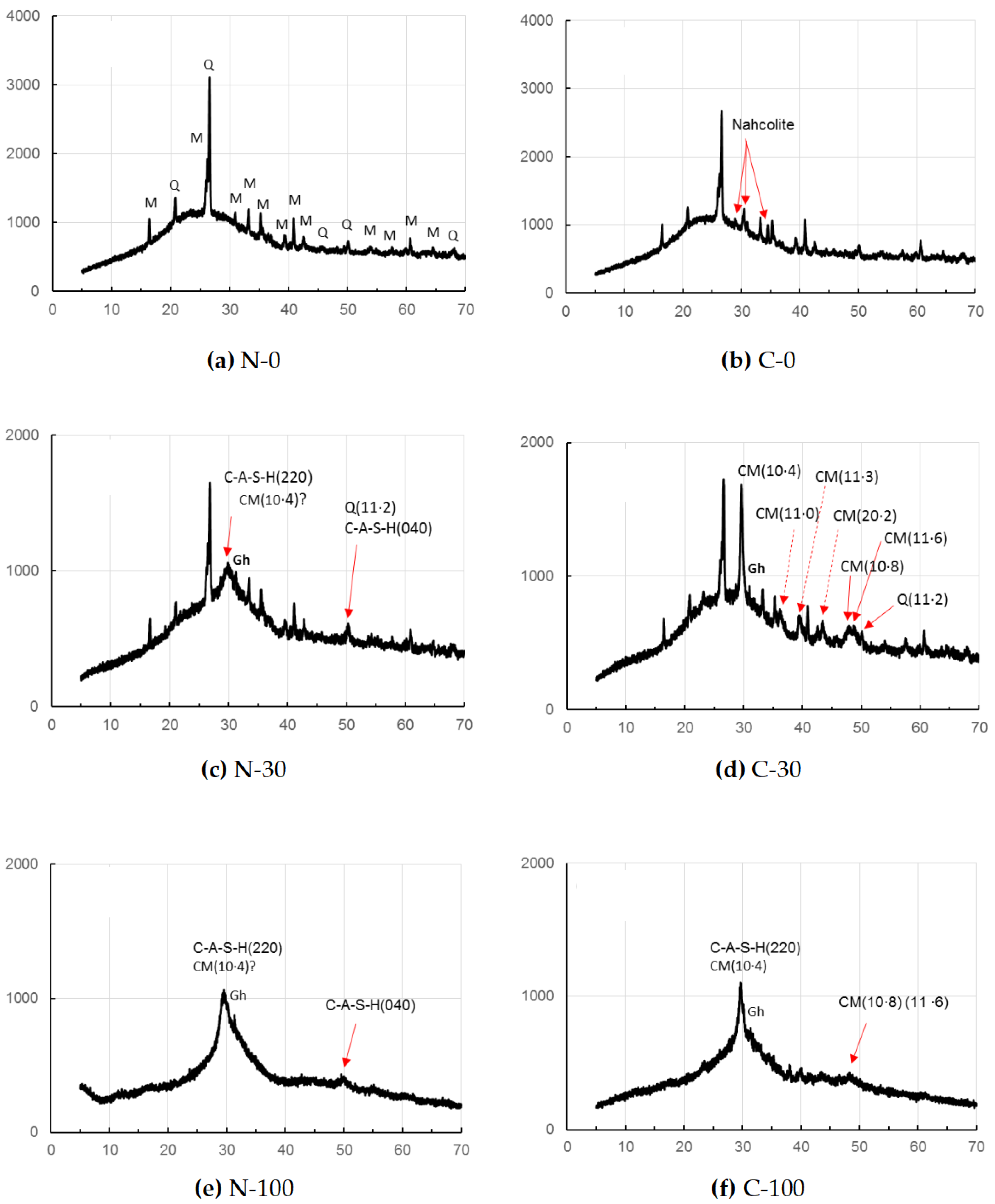
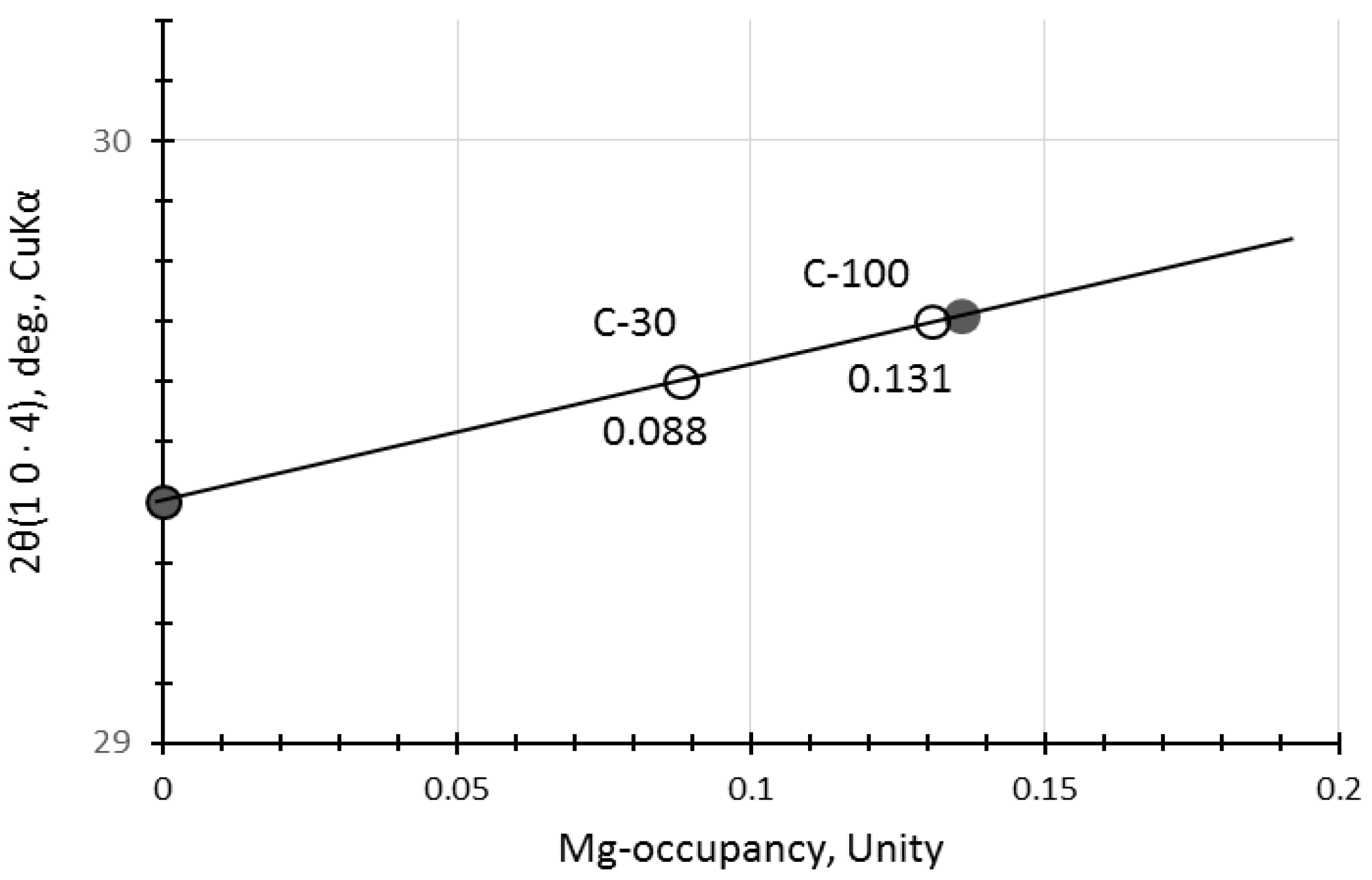
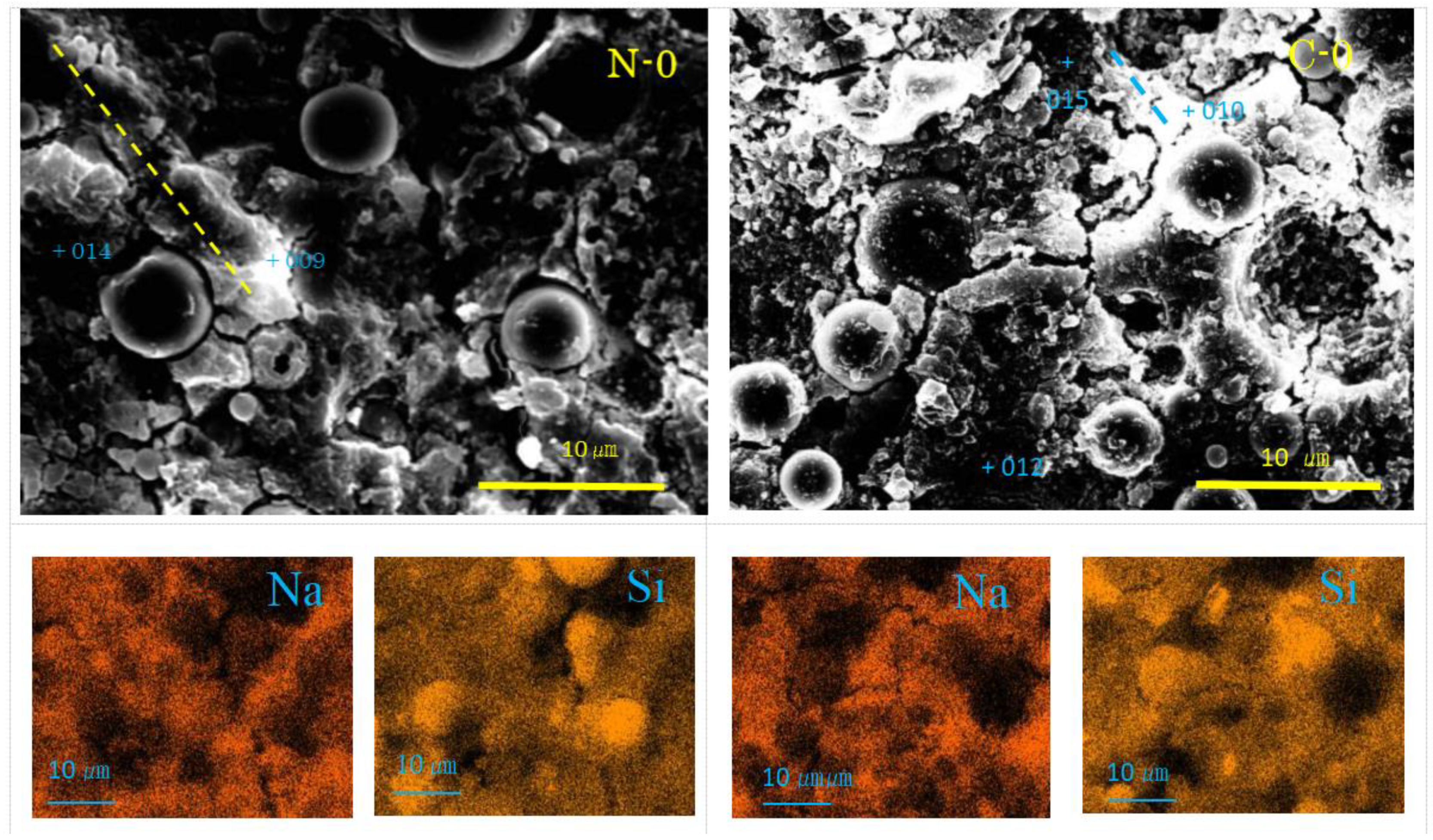
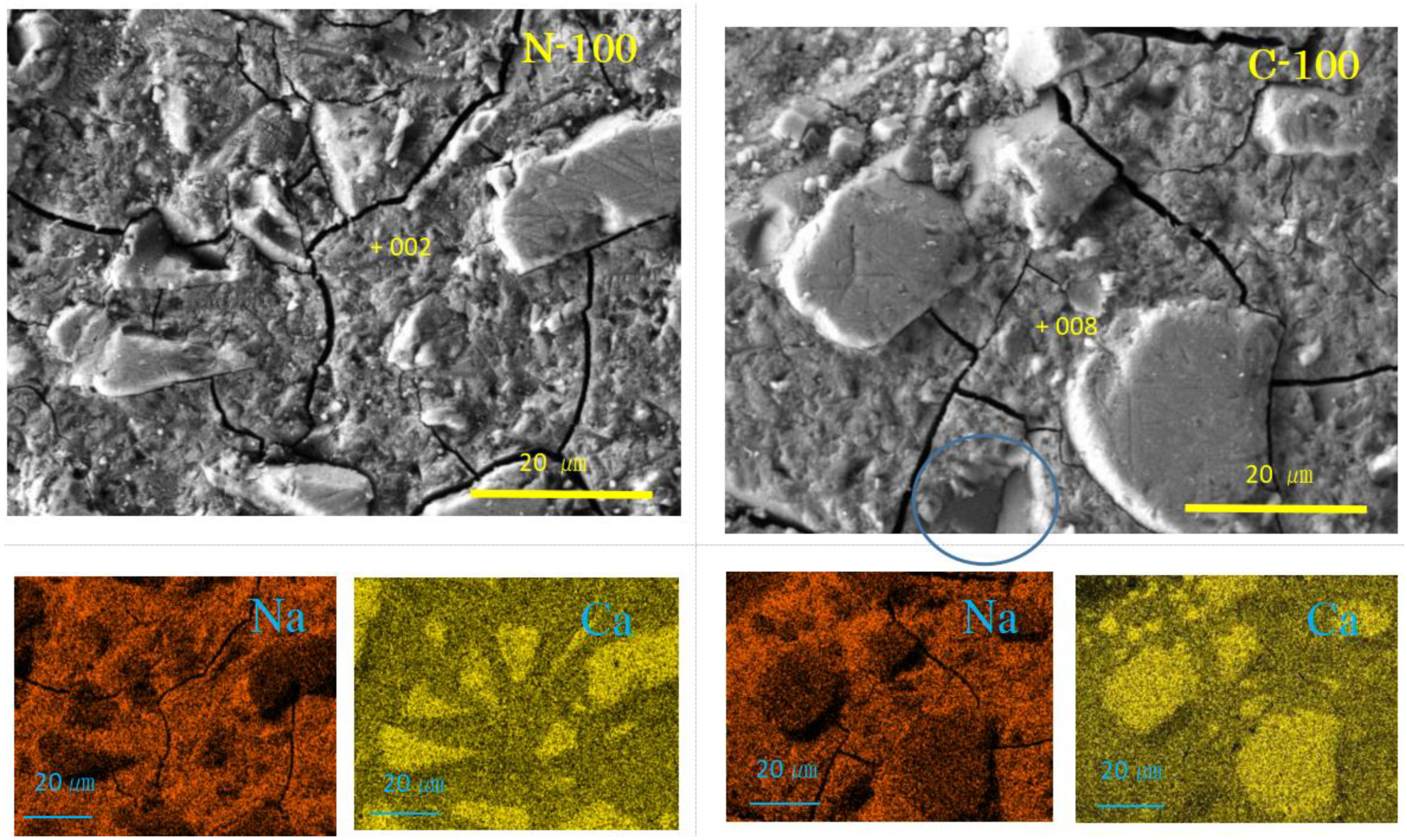
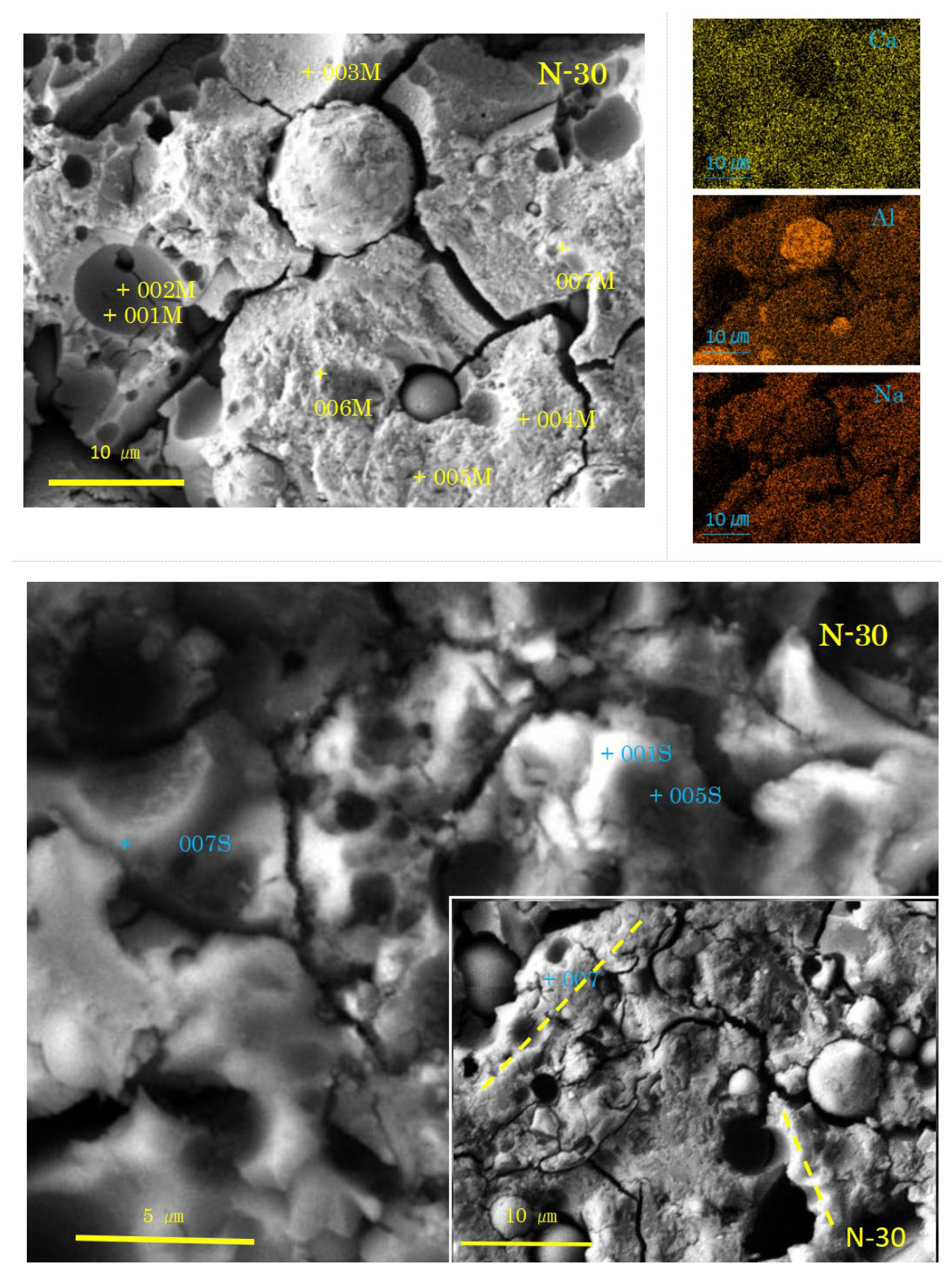
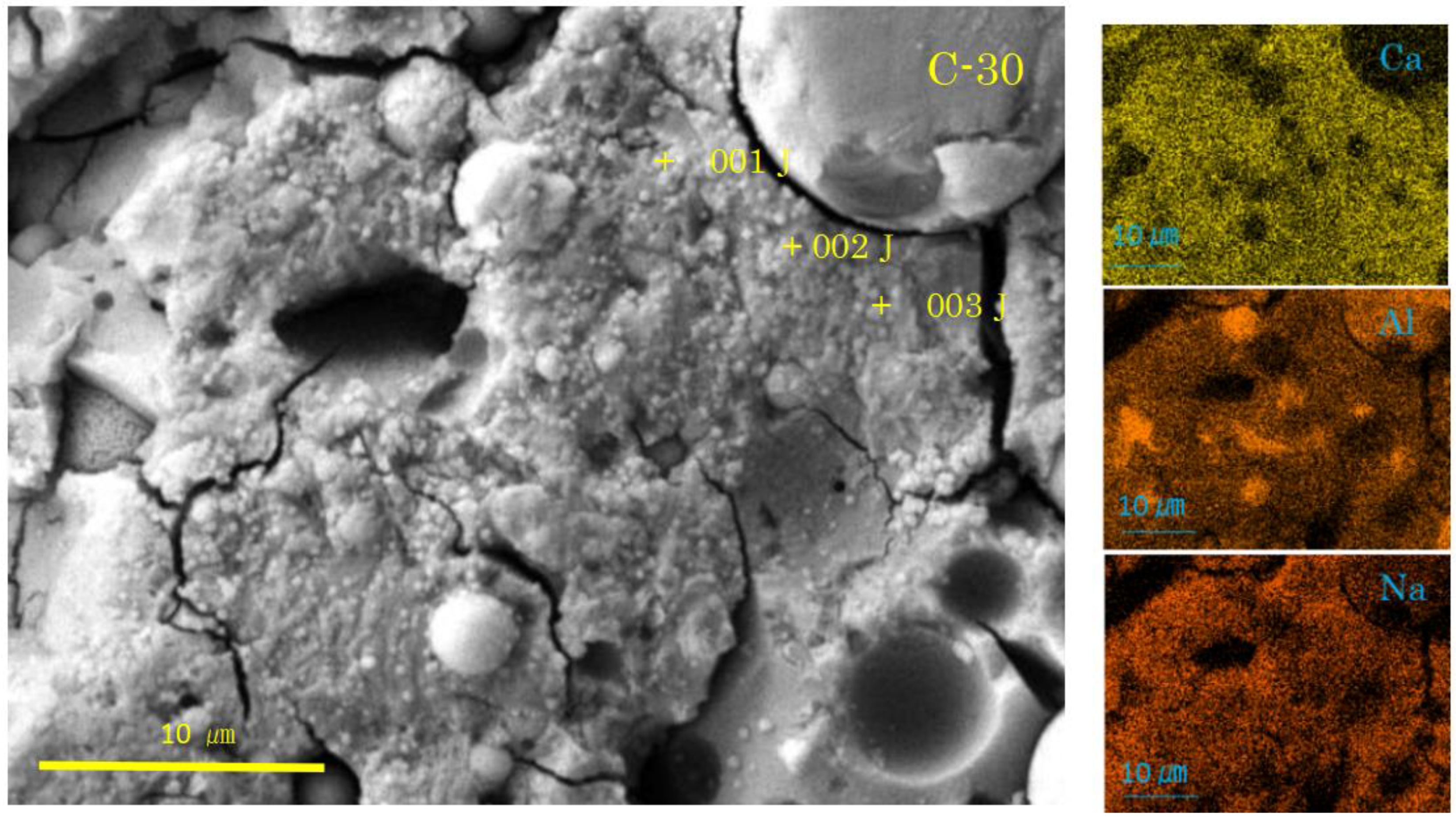
| SiO2 | TiO2 | Al2O3 | Fe2O3 | MnO | CaO | MgO | Na2O | K2O | P2O5 | SO3 | LOI 1 | Density (g/cm3) | SSA 2 (m3/kg) | |
|---|---|---|---|---|---|---|---|---|---|---|---|---|---|---|
| FA | 60.26 | 1.32 | 22.36 | 6.68 | 0.05 | 2.01 | 0.65 | 0.52 | 1.63 | 0.71 | 0.95 | 2.86 | 2.24 | 355 |
| GGBS | 33.54 | 0.55 | 13.99 | 0.33 | 0.20 | 41.72 | 5.32 | 0.24 | 0.24 | 0.04 | 2.47 | 1.40 | 2.89 | 418 |
| No. | FA: GGBS (Mass Ratio) | Non- Carbonation | Accelerated Carbonation | GP-Liquor/Filler Ratio (by Mass) |
|---|---|---|---|---|
| 1. | 100:0 | N-0 | C-0 | 0.5 |
| 2. | 70:30 | N-30 | C-30 | 0.5 |
| 3. | 0:100 | N-100 | C-100 | 0.5 |
| N-A-S-H | |||||||||||||
| Remark | Spot 1 | SiO2 | TiO2 | Al2O3 | Fe2O3 | CaO | MgO | Na2O | K2O | P2O5 | SO3 | C/N | (C + M)/N |
| Beads | N-0-9 | 63.67 | 0.76 | 12.52 | 1.82 | 3.35 | 1.07 | 11.32 | 0.90 | 2.23 | 2.37 | 0.30 | 0.39 |
| Beads | N-0-10 | 58.98 | 0.28 | 22.81 | 1.21 | 2.85 | 0.79 | 10.11 | 0.52 | 0.95 | 1.51 | 0.28 | 0.36 |
| Beads | N-0-11 | 63.61 | 0.49 | 9.53 | 1.78 | 4.55 | 1.13 | 14.18 | 0.69 | 1.92 | 2.12 | 0.32 | 0.40 |
| N-0-12 | 58.78 | 0.90 | 24.23 | 1.86 | 3.26 | 1.34 | 5.66 | 0.40 | 1.68 | 1.88 | 0.58 | 0.81 | |
| N-0-13 | 71.55 | 0.62 | 9.51 | 4.55 | 4.26 | 0.66 | 4.03 | 1.27 | 1.69 | 1.86 | 1.06 | 1.22 | |
| N-0-14 | 68.91 | 0.85 | 10.00 | 2.46 | 5.07 | 0.90 | 7.12 | 0.85 | 1.53 | 2.32 | 0.71 | 0.84 | |
| N-0-15 | 70.88 | 0.73 | 9.27 | 5.07 | 4.17 | 1.17 | 3.14 | 1.61 | 1.88 | 2.09 | 1.33 | 1.70 | |
| N-0-16 | 69.44 | 0.41 | 8.13 | 1.59 | 3.57 | 1.53 | 10.62 | 0.64 | 1.56 | 2.49 | 0.34 | 0.48 | |
| N-0-17 | 65.49 | 1.15 | 9.80 | 2.85 | 5.75 | 1.31 | 7.80 | 0.89 | 2.34 | 2.61 | 0.74 | 0.91 | |
| N-0-18 | 67.41 | 0.52 | 12.78 | 1.79 | 3.77 | 1.41 | 6.88 | 0.72 | 2.06 | 2.65 | 0.55 | 0.75 | |
| C-A-S-H | |||||||||||||
| Remark | Spot 1 | SiO2 | TiO2 | Al2O3 | Fe2O3 | CaO | MgO | Na2O | K2O | P2O5 | SO3 | C/N | (C + M)/N |
| Beads | N-30-1 | 53.31 | 0.59 | 8.39 | 1.09 | 24.31 | 4.95 | 3.16 | 0.31 | 1.35 | 2.55 | 7.69 | 9.26 |
| N-30-3 | 53.75 | 0.35 | 7.68 | 0.72 | 28.51 | 3.42 | 3.01 | 0.24 | 0.64 | 1.68 | 9.47 | 10.61 | |
| Beads | N-30-4 | 54.42 | 0.45 | 10.79 | 0.95 | 20.26 | 4.47 | 4.53 | 0.36 | 1.20 | 2.57 | 4.47 | 5.46 |
| N-30-5 | 56.80 | 0.57 | 8.04 | 1.02 | 20.72 | 4.00 | 4.22 | 0.45 | 1.10 | 3.07 | 4.91 | 5.86 | |
| Beads | N-30-6 | 53.94 | 0.42 | 10.91 | 0.80 | 19.00 | 4.98 | 5.48 | 0.35 | 1.29 | 2.82 | 3.47 | 4.38 |
| Beads | N-30-7 | 80.64 | .0.21 | 4.36 | 0.41 | 8.51 | 1.97 | 1.97 | 0.20 | 0.42 | 1.30 | 4.32 | 5.32 |
| Beads | N-30-8 | 63.31 | 0.28 | 8.81 | 0.74 | 14.87 | 4.04 | 4.94 | 0.26 | 0.95 | 1.80 | 3.01 | 3.83 |
| N-30-9 | 56.80 | 0.37 | 8.59 | 0.80 | 19.37 | 4.86 | 4.53 | 0.31 | 0.92 | 3.45 | 4.28 | 5.35 | |
| Beads | N-30-10 | 52.96 | 0.36 | 9.43 | 0.88 | 20.56 | 5.40 | 6.28 | 0.22 | 1.39 | 2.52 | 3.27 | 4.13 |
| Beads | N-30-11 | 55.81 | 0.40 | 10.04 | 0.74 | 18.03 | 5.46 | 5.58 | 0.34 | 1.10 | 2.49 | 3.23 | 4.21 |
| N-30-3D | 54.41 | 0.64 | 4.34 | 1.63 | 27.75 | 5.87 | 4.37 | 0.19 | 0.04 | 0.75 | 6.35 | 7.69 | |
| N-30-4D | 57.87 | 0.59 | 5.33 | 1.89 | 23.92 | 4.69 | 4.47 | 0.36 | 0.09 | 0.80 | 5.35 | 6.40 | |
| Beads, Cotton | N-30-1S | 59.89 | 0.28 | 5.67 | 3.29 | 20.19 | 6.71 | 3.37 | 0.29 | 0.08 | 0.22 | 5.99 | 7.98 |
| Beads, Cotton | N-30-2S | 59.04 | 0.43 | 5.41 | 2.19 | 21.55 | 4.61 | 5.68 | 0.23 | 0.05 | 0.80 | 3.79 | 4.61 |
| Pit | N-30-5S | 59.55 | 0.34 | 6.22 | 2.62 | 23.79 | 3.81 | 2.72 | 0.34 | 0.02 | 0.61 | 8.74 | 10.14 |
| Pit(ring) | N-30-7S | 57.22 | 0.41 | 5.36 | 1.45 | 20.95 | 4.57 | 9.16 | 0.22 | 0.04 | 0.62 | 2.29 | 2.79 |
| Pit | N-30-1M | 38.69 | 1.73 | 5.13 | 1.98 | 44.08 | 1.37 | 1.85 | 0 | 1.20 | 4.06 | 23.83 | 24.57 |
| Pit | N-30-2M | 37.45 | 0 | 4.12 | 2.26 | 46.40 | 0.80 | 1.54 | 0.29 | 2.29 | 4.85 | 30.13 | 30.65 |
| Pit | N-30-3M | 53.01 | 0.18 | 9.24 | 0.5 | 14.39 | 5.31 | 7.85 | 0.2 | 4.29 | 5.04 | 1.83 | 2.51 |
| N-30-4M | 54.48 | 0.48 | 8.71 | 0.44 | 13.68 | 6.01 | 4.95 | 0.18 | 5.75 | 5.33 | 2.76 | 3.98 | |
| N-30-5M | 54.26 | 0.09 | 8.90 | 0.29 | 13.07 | 5.49 | 5.73 | 0.27 | 5.51 | 6.38 | 2.28 | 3.24 | |
| N-30-6M | 51.46 | 0.28 | 8.62 | 0.72 | 12.38 | 5.63 | 6.99 | 0.06 | 6.41 | 7.44 | 1.77 | 2.58 | |
| N-30-7M | 49.14 | 0.26 | 7.92 | 0.69 | 15.06 | 5.09 | 6.74 | 0.24 | 7.58 | 7.27 | 2.23 | 2.99 | |
| C-A-S-H | |||||||||||||
| Remark | Spot 1 | SiO2 | TiO2 | Al2O3 | Fe2O3 | CaO | MgO | Na2O | K2O | P2O5 | SO3 | C/N | (C + M)/N |
| N-100-2 | 37.56 | 0.48 | 7.97 | 0.07 | 26.81 | 15.76 | 8.21 | 0.09 | 1.15 | 1.89 | 3.27 | 5.19 | |
| N-100-6 | 42.88 | 0.40 | 6.01 | 0.07 | 35.68 | 4.97 | 5.19 | 0.26 | 1.55 | 2.99 | 6.87 | 7.83 | |
| N-100-7 | 45.17 | 0.12 | 6.87 | 0.08 | 30.24 | 4.86 | 8.85 | 0.04 | 1.43 | 2.35 | 3.42 | 3.97 | |
| N-100-8 | 43.66 | 0.08 | 6.77 | 0.15 | 29.36 | 5.78 | 10.19 | 0.10 | 1.29 | 2.62 | 2.88 | 3.45 | |
| N-100-9 | 42.94 | 0.20 | 6.40 | 0 | 32.43 | 4.53 | 8.95 | 0.17 | 1.46 | 2.93 | 3.62 | 4.13 | |
| N-A-S-H | |||||||||||||
| Remark | Spot 1 | SiO2 | TiO2 | Al2O3 | Fe2O3 | CaO | MgO | Na2O | K2O | P2O5 | SO3 | C/N | (C + M)/N |
| Beads | C-0-9 | 83.65 | 0.18 | 6.48 | 0.60 | 0.46 | 0.74 | 3.49 | 0.53 | 1.87 | 2.01 | 0.13 | 0.34 |
| Beads | C-0-10 | 71.63 | 0.38 | 6.28 | 1.13 | 1.60 | 0.80 | 12.91 | 0.50 | 1.89 | 2.87 | 0.12 | 0.19 |
| Beads | C-0-11 | 60.49 | 0.45 | 9.04 | 1.40 | 2.69 | 1.14 | 17.83 | 0.49 | 2.89 | 3.58 | 0.15 | 0.21 |
| C-0-12 | 66.08 | 0.44 | 8.39 | 2.34 | 3.49 | 0.84 | 10.43 | 0.66 | 2.47 | 4.85 | 0.33 | 0.42 | |
| C-0-13 | 67.73 | 0.79 | 9.80 | 2.93 | 5.92 | 1.23 | 6.18 | 0.91 | 1.29 | 3.23 | 0.96 | 1.16 | |
| C-0-14 | 65.27 | 0.42 | 7.97 | 1.61 | 4.74 | 1.33 | 12.61 | 0.56 | 2.14 | 3.35 | 0.38 | 0.48 | |
| C-0-15 | 67.85 | 1.31 | 6.78 | 4.42 | 8.28 | 0.50 | 4.30 | 1.26 | 1.78 | 3.51 | 1.93 | 2.04 | |
| C-A-S-H | |||||||||||||
| Remark | Spot 1 | SiO2 | TiO2 | Al2O3 | Fe2O3 | CaO | MgO | Na2O | K2O | P2O5 | SO3 | C/N | (C + M)/N |
| C-30-6 | 52.77 | 0.49 | 10.22 | 0.82 | 23.26 | 4.38 | 5.90 | 0.46 | 0.13 | 1.56 | 3.94 | 4.68 | |
| C-30-7 | 53.76 | 0.65 | 8.98 | 1.17 | 18.15 | 4.76 | 11.07 | 0.44 | 0.02 | 1.00 | 1.64 | 2.07 | |
| Hail 2, CR 3 | C-30-1F | 29.76 | 0.34 | 5.02 | 0.53 | 48.42 | 3.95 | 7.08 | 0.21 | 2.02 | 2.68 | 6.84 | 7.40 |
| Hail, CR | C-30-2F | 42.29 | 0.44 | 7.02 | 0.8 | 34.60 | 3.68 | 4.72 | 0.31 | 2.75 | 3.39 | 7.33 | 8.11 |
| Hail, CR | C-30-3F | 42.39 | 0.58 | 7.64 | 0.46 | 32.27 | 3.65 | 6.18 | 0.42 | 3.05 | 3.36 | 5.22 | 5.81 |
| Hail, CR | C-30-4F | 46.94 | 0.53 | 7.00 | 0.88 | 31.89 | 3.85 | 4.24 | 0.42 | 1.74 | 2.51 | 7.52 | 8.43 |
| C-30-5F | 52.84 | 0.53 | 7.41 | 1.00 | 25.29 | 3.88 | 3.86 | 0.39 | 1.67 | 3.12 | 6.55 | 7.56 | |
| Hail | C-30-1J | 51.81 | 0.28 | 7.50 | 0.77 | 21.85 | 4.80 | 7.62 | 0.34 | 2.00 | 3.02 | 2.87 | 3.50 |
| Hail | C-30-2J | 52.94 | 0.52 | 8.59 | 0.64 | 21.32 | 5.50 | 5.68 | 0.40 | 1.45 | 2.96 | 3.75 | 4.72 |
| Hail, CR | C-30-3J | 47.99 | 0.59 | 7.68 | 0.86 | 28.37 | 4.52 | 4.39 | 0.34 | 2.07 | 3.19 | 6.46 | 7.49 |
| C-A-S-H | |||||||||||||
| Remark | Spot 1 | SiO2 | TiO2 | Al2O3 | Fe2O3 | CaO | MgO | Na2O | K2O | P2O5 | SO3 | C/N | (C + M)/N |
| C-100-6 | 45.61 | 0.51 | 7.23 | 0 | 29.86 | 7.21 | 6.13 | 0.16 | 1.21 | 2.08 | 4.87 | 6.05 | |
| C-100-7 | 47.10 | 0.22 | 7.08 | 0 | 31.18 | 5.26 | 5.68 | 0.22 | 1.26 | 2.01 | 5.49 | 6.42 | |
| C-100-8 | 43.61 | 0.36 | 6.88 | 0.04 | 30.87 | 7.94 | 7.02 | 0.04 | 1.16 | 2.09 | 4.40 | 5.53 | |
| C-100-9 | 44.68 | 0.22 | 6.67 | 0.04 | 31.16 | 5.50 | 8.09 | 0.32 | 1.08 | 2.23 | 3.85 | 4.53 | |
Disclaimer/Publisher’s Note: The statements, opinions and data contained in all publications are solely those of the individual author(s) and contributor(s) and not of MDPI and/or the editor(s). MDPI and/or the editor(s) disclaim responsibility for any injury to people or property resulting from any ideas, methods, instructions or products referred to in the content. |
© 2024 by the authors. Licensee MDPI, Basel, Switzerland. This article is an open access article distributed under the terms and conditions of the Creative Commons Attribution (CC BY) license (https://creativecommons.org/licenses/by/4.0/).
Share and Cite
Li, Z.; Ikeda, K. Compositions and Microstructures of Carbonated Geopolymers with Different Precursors. Materials 2024, 17, 1491. https://doi.org/10.3390/ma17071491
Li Z, Ikeda K. Compositions and Microstructures of Carbonated Geopolymers with Different Precursors. Materials. 2024; 17(7):1491. https://doi.org/10.3390/ma17071491
Chicago/Turabian StyleLi, Zhuguo, and Ko Ikeda. 2024. "Compositions and Microstructures of Carbonated Geopolymers with Different Precursors" Materials 17, no. 7: 1491. https://doi.org/10.3390/ma17071491






